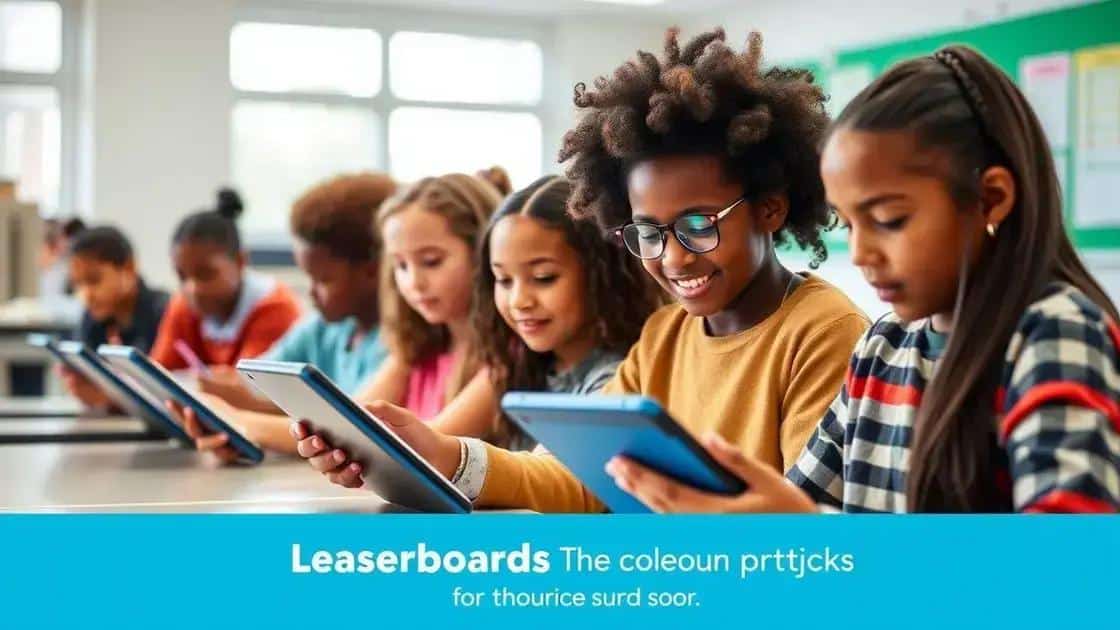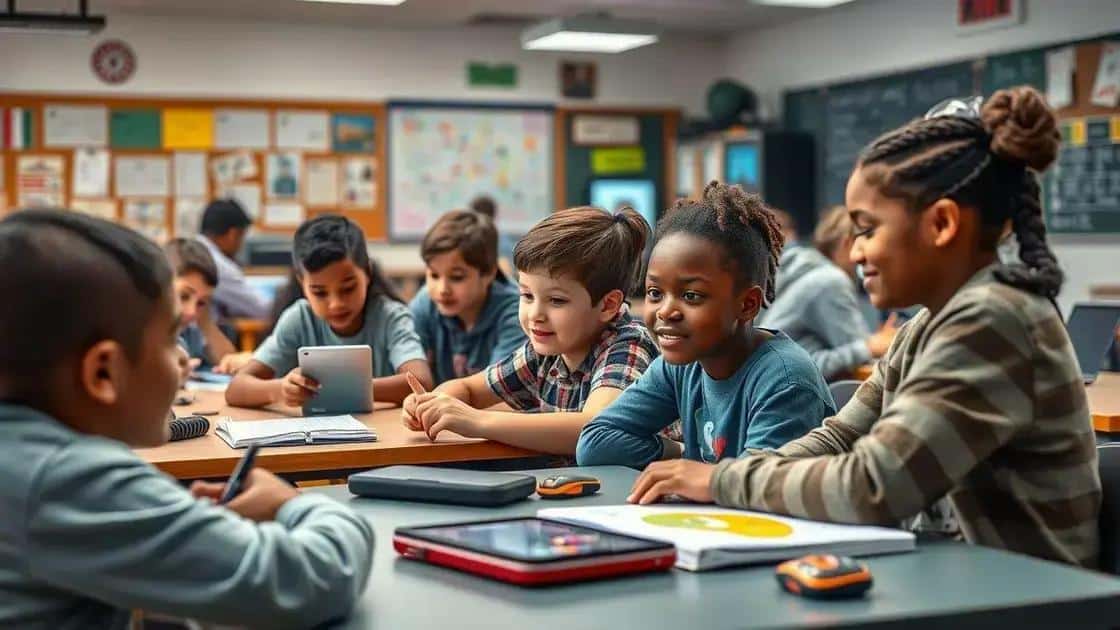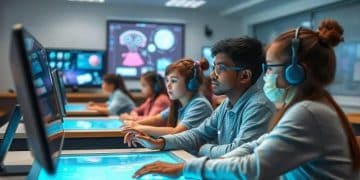Gamified learning platforms trends you need to know

Gamified learning platforms enhance education by using game elements to increase student engagement, motivation, and knowledge retention, while addressing challenges like technology access and user engagement.
Gamified learning platforms trends are changing the landscape of education today. Have you ever wondered how games can make learning more engaging and effective? Let’s dive into this exciting topic.
Understanding gamified learning platforms
Understanding gamified learning platforms is essential in today’s educational landscape. These platforms use game-based elements to engage students and enhance their learning experience. The idea is simple: when learning feels more like a game, students are more likely to participate and stay motivated.
One key aspect of gamified platforms is how they incorporate interactive elements. These features often include points, badges, and leaderboards, which help track progress and provide a sense of achievement. By making learning more interactive, students can retain information better.
Core Components of Gamified Learning
There are several core components that make these platforms effective:
- Point systems: Students earn points for completing tasks or reaching milestones, which encourages continuous engagement.
- Badges: Badges serve as rewards for specific achievements, motivating students to strive for more.
- Leaderboards: These foster a sense of competition, pushing students to improve their performance.
- Storytelling: Many gamified platforms include narratives that draw students in, making learning feel like an adventure.
Moreover, customization is a vital element in these platforms. They often allow students to choose their paths and set their goals. This personalized approach caters to different learning styles and paces, enhancing overall satisfaction with the educational content.
In addition, feedback is immediate in these environments. Students receive instant results on quizzes or tasks, helping them identify areas needing improvement quickly. This immediate reinforcement aids in knowledge retention.
As technology advances, more features will likely emerge, making gamified learning even more compelling. These platforms are not just a passing trend; they represent the future of education where engagement and motivation are at the forefront.
Key trends shaping gamified learning

Many exciting key trends are currently shaping gamified learning. These trends are not just fads; they represent a shift in how we approach education. By understanding these trends, educators can create more effective and engaging learning environments.
Integration of Artificial Intelligence
Artificial Intelligence (AI) is becoming a vital component of gamified learning platforms. With AI, these platforms can customize the learning experience based on each student’s needs. For example, AI can help identify a student’s strengths and weaknesses, allowing for a tailored approach.
- Personalized learning paths: AI can adapt the content to suit individual learning speeds and styles.
- Real-time feedback: AI provides immediate responses, enabling students to understand their performance right away.
- Predictive analytics: By analyzing data, AI can predict future performance trends, helping educators intervene early.
Another trend is the incorporation of social learning features. Platforms are increasingly allowing for collaboration among students. This interaction can boost engagement and make learning more enjoyable. When students can share achievements, work on projects together, and support each other’s learning, the entire group benefits.
Moreover, the use of mobile gamification is rising. With the widespread availability of smartphones and tablets, learning can happen anywhere. This accessibility encourages students to engage outside the traditional classroom.
Furthermore, gamified learning is now leaning towards data-driven decisions. Educators are using analytics to assess how effective the gamified elements are in boosting student engagement and comprehension. This information helps refine the learning experience continuously.
These trends in gamified learning are evolving quickly. As technology advances, we can expect even more innovative features that will make learning interactive and immersive. Staying updated with these trends is crucial for educators aiming to enhance their teaching methods.
Benefits of using gamification in education
Using gamification in education offers numerous benefits that enhance learning experiences. By integrating game-like elements, educators can create an environment that encourages students to engage actively with the material. This active participation is vital for deeper learning and retention of information.
Increased Engagement
One of the most significant benefits is increased student engagement. When learning feels like a game, students are more likely to participate. They enjoy working towards goals and earning rewards, which motivates them to complete tasks.
- Fun learning experiences: Gamification makes education enjoyable, transforming mundane lessons into exciting challenges.
- Interactive activities: Students are drawn to interactive content, wanting to explore and compete with their peers.
- Instant feedback: Games often provide immediate feedback, helping students understand their progress.
This approach fosters a sense of achievement among students. As they complete levels or earn badges, they build confidence. This boost in self-esteem can encourage students to take on more significant challenges.
Improved Retention of Knowledge
Another vital benefit of gamification is improved retention of knowledge. When concepts are presented in a playful way, students remember them better. Engaging with material through games leads to a more profound understanding.
Gamified learning often involves storytelling, creating narratives that resonate with students. These stories help frame learning objectives in relatable contexts, making them more memorable.
Moreover, competition is a natural motivator. When students see their peers excelling, they are likely to strive for similar success. This friendly competition can lead to a more productive classroom environment.
The adaptability of gamified learning also plays a role in its effectiveness. Platforms can cater to individual learning speeds, allowing each student to progress at their pace. This personalization keeps students motivated, preventing frustration from feeling left behind.
Challenges and future of gamified learning

The world of gamified learning comes with its own set of challenges. These challenges are important to address as they can impact the effectiveness of educational platforms. Understanding these hurdles helps educators and developers create better solutions.
Technology Access and Equity
One major challenge is the disparity in technology access. Not every student has the same access to devices and high-speed internet. This can lead to a gap in learning opportunities, particularly for students in underserved areas.
- Device availability: Some students may not have access to tablets or laptops at home.
- Internet connectivity: A reliable internet connection is essential for using gamified platforms effectively.
- Support and training: Teachers and students often need training to use technology effectively, and not all schools provide this support.
Additionally, creating engaging content that also aligns with curriculum standards is a significant challenge. Developers must balance entertainment with educational value. Maintaining this balance can be tricky.
User Engagement
Another challenge involves sustaining long-term user engagement. While gamification can initially attract students, keeping them interested over time requires continuous innovation and adaptation.
Furthermore, some students may not respond positively to competition. Some may find the competitive aspect overwhelming or discouraging. Recognizing different learning styles and preferences is essential for making gamified learning more inclusive.
Looking to the future, advancements in technology may help overcome some of these challenges. For instance, incorporating virtual reality (VR) and augmented reality (AR) could create more immersive learning experiences. These technologies can engage students in new ways, making education more interactive.
Moreover, leveraging artificial intelligence can provide personalized learning experiences for students. AI can adapt to each student’s progress, helping sustain their interest over longer periods. This adaptability could improve learning outcomes significantly.
In conclusion, gamified learning platforms are transforming education by making it more engaging and effective. As we’ve explored, these platforms offer benefits such as increased student motivation and improved retention of information. However, challenges like technology access and maintaining long-term engagement remain. Looking ahead, embracing new technologies like AI and VR can help overcome these hurdles and enhance the learning experience. By understanding and navigating these aspects, educators can create a more inclusive and stimulating environment for all students.
\n\n
\n
FAQ – Questions Frequently Asked About Gamified Learning Platforms
What are gamified learning platforms?
Gamified learning platforms use game elements to enhance the educational experience, making learning more engaging and interactive.
How does gamification increase student motivation?
Gamification motivates students by providing rewards, such as points and badges, which create a sense of achievement and encourage participation.
What challenges do educators face when using gamified learning?
Challenges include ensuring equal access to technology, maintaining long-term engagement, and creating content that aligns with curriculum standards.
What is the future of gamified learning in education?
The future looks promising, with advancements in AI and virtual reality likely to create even more interactive and personalized learning experiences.





